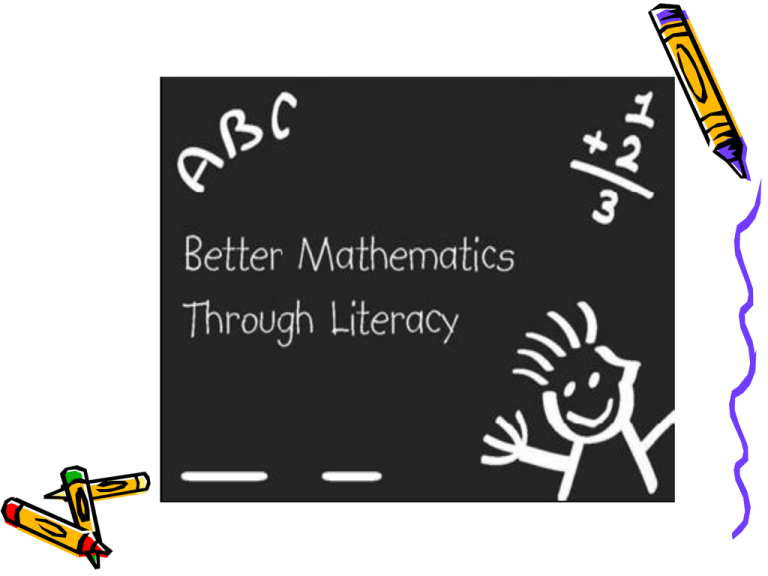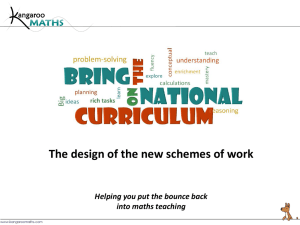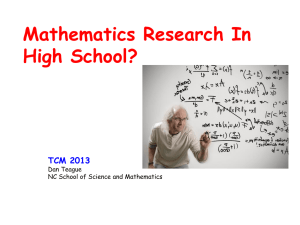ppt - 2012
advertisement

WELCOME! I CAN’T USE THIS BOOK FOR MATH; THERE’S NO NUMBERS IN THE TITLE! Dr. Timothy McKeny Ohio University Ohio Council of Teachers of Mathematics October 18, 2012 The Common Core Standards in the Early and Middle Grades NCTM, NCTE, and NAEYC agree! • Elementary [and Middle grade] students need high-quality, challenging, and accessible mathematics education. • Understanding and using mathematics increases educational and social opportunities for productive futures. • Instructional activities should continually engage children and lead them to construct mathematical understanding. • The artificial separation of mathematics and language is very unnatural in developing understanding. • Both literature and mathematics help us organize and give order to the world around us. Mathematics Reform Efforts • National Council of Teachers of Mathematics, 2007; 2001 • National Mathematics Advisory Panel, 2008 • National Research Council, 2008; 2001 • Common Core State Standards Initiative, 2009 • Partnership for 21st Century Skills, 2009 • NCTM and National Association for the Education of Young Children, 2002 But… Teachers challenged with implementing reformbased mathematics often default to teacherdirected approaches that rely on: • The memorization of isolated facts, • Repeated use of algorithms that have no inherent meaning, • Math classrooms that operate within a sanctioned silence. (Boaler, 2008; Van De Walle & Lovin, 2008) “The mathematics and the understanding that the Common Core State Standards for Mathematics require is not usually the mathematics that elementary and middle school inservice teachers experienced in their past (Wilburne, Keat, & Napoli, 2011). Without a clear vision of what learning to teach mathematics through constructivist means looks like and sounds like, elementary grade teachers tend to adopt a teaching style that closely mirrors their own learning experiences as students (Ball, 1990; Thompson, 1984). “But, in expanding the definition of ‘text’ to include anything that provides readers, writers, listeners, speakers, and thinkers with the potential to create meaning through language can begin to open up his or her classroom to student thinking, student discourse, and sense-making” (Draper, 2002) BMTL – who we are • Dr. Timothy McKeny (PI) • Dr. Susan Nolan • Ms. Sue Payne • Ms. Kate Leeman • Dr. Linda Rice • Mr. Brian McCoy • Ms. Chelsie Wollett • Mr. Derek Sturgill • Ms. Carolyn Ervin BMTL – what we are BMTL is a professional development opportunity for inservice elementary teachers and intervention specialists. BMTL examines ways of teaching elementary mathematics through engaging, learner-centered activities, through the infusion of the CCSSM Mathematical Practices, and through the use of writing, reading, and communicating. BMTL – what we are BMTL Participants gain pedagogical knowledge and pedagogical content knowledge in the blending of the mathematics and literacy. Participants are motivated to explore studentcentered mathematics instruction by the incorporation of mathematically rich tasks that create a classroom atmosphere conducive to meaningful learning, community building, and naturalistic inquiry. BMTL – what we are BMTL builds mathematical understanding for participants and students through “tales, tasks, tools, and talk” (McKeny and Foley, in press). Integrating Mathematics and Literacy is NOT new! • Writing in Math Class (Burns, 1995). • Literacy Strategies for Improving Mathematics Instruction • My Kids Can: Making Math Accessible to All Learners (Storygard, • Exploring Mathematics through Literature (Thiessen, 2004). • Literacy + Math = Creative Connections in the Elementary Classroom (Altieri, 2012). • Cowboys Count, Monkeys Measure, and Princesses Problem Solve: Building Early Math Skills through Storybooks (Wilburne, Keat, & (Kenney, 2005) 2009). Napoli, 2011). Let’s Try This! The Monster Who Did My Math Written by: Danny Schnitzlein Illustrated by: Bill Mayer Peachtree Publishers, 2007 ISBN: 978-1-56145-420-4 • • • • Grade Level(s): __________________ Title: _________________________ Author ________________________ Illustrator: _____________________ Mathematical Task with PLOT: Mathematical Task with CHARACTERS: • Book Synopsis: • PLOT: • CHARACTERS: • ILLUSTRATIONS: • SETTING: Mathematical Task with ILLUSTRATIONS: Mathematical Task with SETTING: Mathematical Task with OBJECTS: • OBJECTS: • TIME FRAME: Mathematical Task with TIME FRAME: Problem Posing with PLOT Examples: List actions in a logical order Clues to identify a part of the story Compare actions Make predictions based on evidence Connect the plot to a math concept Redesign the plot to include mathematics A “math walk” through the story Explore conjectures, estimations, generalizations Mathematical Task with PLOT Let’s pretend that the Monster in our story charges the boy 35¢ for each multiplication problem and 60¢ for each division problem he solves. How many types of each problem did the Monster solve if the boy’s bill is $15? How many different solutions can you find? Problem Posing with CHARACTER Make the Character(s) come to life Put the Character(s) in the students’ classroom, bedroom, kitchen, or community park Make the story real to children: what open-ended tasks can characters face? Mathematical Task with CHARACTER Let’s pretend that the Monster’s Magic Calculator has broken. How did the Monster use the Magic Calculator to get the homework answers of: -10 1 Only the 5, the 2, 3 10 the ×, the −, and the = buttons work. 24 100 Problem Posing with ILLUSTATIONS Illustrations can: Capture students’ interest and imagination Visualize the mathematics Enhance the details of the narrative Place mathematics in a meaningful context Mathematical Task with ILLUSTRATIONS How many different monster faces can you make from 4 different sets of scary eyes, 3 different eerie noses, and 3 different sets of pointy teeth? Problem Posing with SETTING Consider how the students can relate to the setting. Settings help to create integrated teaching units. Students can begin to see the mathematics in the everyday. Mathematical Task with SETTING Respond to our class survey about the places where we do our math homework. 1)At the kitchen table 2)In my room at home 3)At the library 4)At a friend’s house Draw a graph to display the results. Problem Posing with OBJECTS Familiarity (and unfamiliarity) with objects in the story provide learning opportunities. Objects in stories can be compared, contrasted, sorted, and classified. (Got Van Hiele?) Objects in stories can be described or constructed with 2D and 3D shapes Mathematical Task with OBJECTS To do the boy’s math homework, the Monster requires a very special type of pen. Pens-R-Us sells 2 pens for $1.40 Pen-Mart sells 3 pens for $1.99 • Which store has the better buy, Pens-R-Us or Pen-Mart? How do you know? • Which store would you go to to buy 24 pens? Show your thinking in words, numbers and pictures. Problem Posing with TIME FRAME The TIME FRAME of a story: Builds understanding of time measurements Creates the necessity for standard units Can bridge a students imagination and reality Allows for comparisons and contrasts Mathematical Task with TIME FRAME Before the boy’s teacher realizes that the Monster is doing the math homework, the Monster has spent 1,725 minutes doing homework. • How long is this in hours? • How long is this in days? • How long is this in weeks? Now it’s your turn! In grade-level groups: interact and collaborate read the storybook use the framework to create mathematical tasks share your tasks with the whole group take this idea back to your schools! Thank you and enjoy OCTM 2012! Dr. Timothy McKeny Department of Teacher Education Ohio University mckeny@ohio.edu







